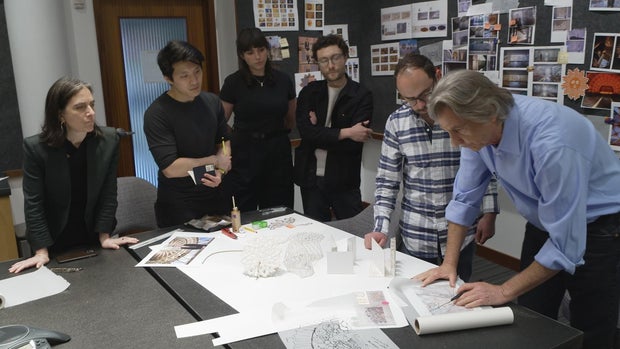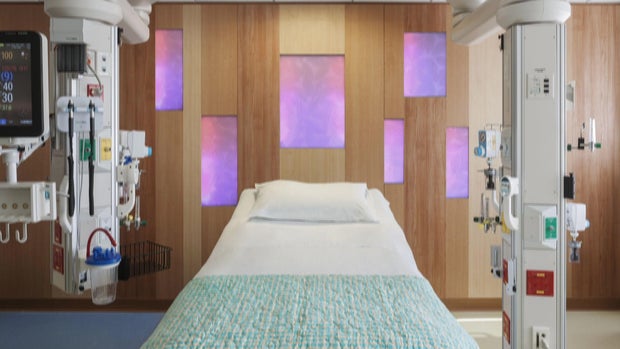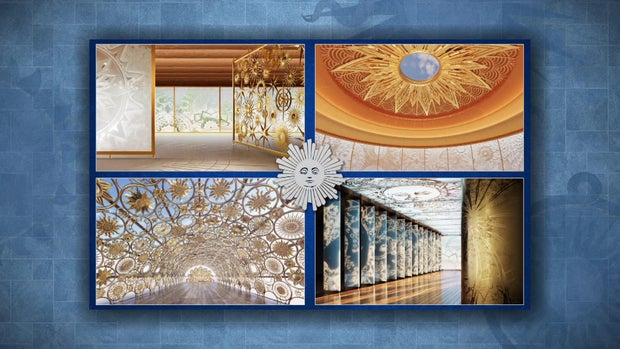For 45 years, the “Sunday Morning” set, created by legendary CBS designer Victor Paganuzzi, served as the backdrop. But for this year’s Design Edition we opted for an update. And who better to reimagine our surroundings (in virtual format) than the eminent design firm Rockwell Group?
“There were things in the CBS Sunday Morning article that were an immediate yes to me,” said David Rockwell, the company’s founder and president. “When I think about it, I think of it as one of the ultimate community rituals. And every project we do is really about celebrating a sense of ritual.
“So we started with a lot of sketches by hand. And when we focused on that, I realized there was an opportunity to do something that had the kind of simplicity and restraint of the original, but had a kind of exuberance and theatrical flair,” he said.
CBS News
Rockwell knows theatrical talent; he designed Hollywood’s Dolby Theatre, home of the Oscars since 2002.
GABRIEL BOUYS/AFP via Getty Images
Its vast portfolio encompasses hotels, stadiums, stages, libraries, playgrounds, airport terminals, bars and restaurants – more than 500 restaurants – since the company was founded in 1984, 40 years ago.
Some Rockwell trademarks? Vibrant and playful screens; wide and imposing stairs; and light, deep, warm and rich.
Rockwell Group
Rockwell said, “My first thoughts about lighting in restaurants come from candles and the restaurants in Guadalajara, where I lived, where the candle was like a fireplace. It’s not always possible to replicate that, but it’s not a bad place to start.”
It’s not all flashy restaurants and luxurious hotels. This children’s hospital emphasizes color and imagination.
Rockwell Group
A temporary observation platform at Ground Zero helped mourners deal with the unthinkable in the months after 9/11. Rockwell said, “What was really needed was a public viewing platform, so people could get an immediate look at what really happened. This temporary structure was definitely one of the most powerful things I’ve ever been involved with.”
Rockwell’s company, which started with fewer than a dozen people, has grown to about 330, with outposts in Los Angeles and Madrid.
“I’m so grateful to be able to do what I do – I feel lucky every day,” he said.
CBS News
And today, “Sunday Morning” is the grateful beneficiary of his creativity.
Rockwell Group’s “CBS Sunday Morning” Project Description
Inspiration and Context
For the 2024 Design Issue, “CBS Sunday Morning’s” annual broadcast of stories from different creative worlds, Rockwell Group wanted to welcome the show’s audience into an imagined world built from foundational elements of the show. “CBS Sunday Morning” and our studio share the belief that audiences are at the center of everything we do, and we both use storytelling as a tool for connection.
Since its first broadcast in 1979, “CBS Sunday Morning” has been a weekly ritual for millions of people who find meaning not only in the day’s headlines, but also in the planes of culture defined by contemporary architecture, performance and the visual arts. . . This ritual has endured in large part thanks to the original set design of “Sunday Morning” by legendary set designer Victor Paganuzzi, who laid the foundation for a program that has offered viewers a solid foundation and nuance for nearly five decades. Likewise, for 40 years, Rockwell Group has been creating ritual experiences for people of all types – no matter the project, we approach everything from a theatrical design perspective, emphasizing narratives that speak to the human experience and make each audience feel feel considered.
The sun is the longtime symbol of “CBS Sunday Morning”; aptly represents the energy and vision he exchanges with his viewers. Over the years, more than 9,000 viewer-created suns have been used on the show – a testament to how the show resonates with viewers of all ages. They also reflect the belief that the ritual of doing connects us across time and space. We participate in this tradition with our own sun, made in-house by a multidisciplinary team.
The Rockwell Group was initially inspired by the French curve – a shape that combines the elegant and the practical, the emotional and the mathematical. French curves have been used for over a century in hand drawing and fashion design to draw smooth curves of various dimensions. From there we developed other concepts. Each sun has its own story and together this tapestry becomes the fundamental building blocks of our design.
Rockwell Group
Design Concept: Architectural Elements
Our design speaks to the magazine-meets-museum approach of “Sunday Morning” and the exchange between the spectacle – the stories of the world – and its viewers; the levels of depth and humanity that can be expressed through transparency and restraint; and the solid foundation the show provides even when we feel the chaos in the world. Our project is a journey through four forms that form the basis of the architecture, built and detailed with artwork created by CBS viewers throughout the show’s history.
We created four design concepts for the show:
Plans and Screens: If the quickest path between two points is a straight line, the simplest architectural path is the plane, the flat or level surfaces, the crucial foundation of any space. We explore the depth achieved through planes: walls, floors and screens. Capturing light and casting shadows, these planes imbue a space with details and nuances that change over time as the sun moves. Our screens are delicately but unmistakably etched with a solar story, informed by the history of the show and its exchange with the audience.
Columns: The simple stacked arrangement of the column allows it to perform an essential task: supporting the load of a building. Over the centuries, columns and our use of them have evolved, creating constraints for designers that, when adopted, can become opportunities. Our columns are cut from metal, lit from within, to shine with the light of the suns and artwork submitted by viewers.
Domes: A curve that can support a structure or create space to draw attention to the air below, domes have been used around the world to articulate how architecture can bend but not break – truth to the idea that good design ideas can resist reality. Our dome, inspired by the Pantheon, includes an oculus to invite sunlight, with ornamentation around the dome, and at ground level, showcasing your audience’s suns.
Limit: Limits anticipate a journey. They create an opportunity for depth, representing invitations to new spaces, new worlds. Every ritual we create begins with this entry and invitation. Here you are welcomed into an ornamental tunnel, a network of suns brought together through simple elegance to achieve depth. At the end of the tunnel we place our contribution to the constellation of suns, a sun made of a French curve, combining the emotional and the mathematical.
Narrative and stories find their meaning in arrangement: as the show progresses, the stories and suns build on what came before. Like Gaudí’s nature-inspired structure approach, our design facilitates dialogue between earth and sky, shadows cast in patterns of memory.
CBS News
For more information:
- Rockwell Group
- Photo credits: Peter Mauss, Frank Oudeman, AVABLU, Nikolas Koenig, Michael Kleinberg, Emily Andrews, Michael Stavaridis, Scott Frances, Eric Laignel, Jason Varney for Rockwell Group, Albert Vecerka and Blandon Belushin
Story produced by Robert Marston. Editor: David Bhagat.































